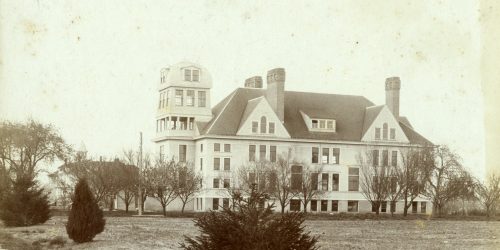
This was the first administration building at Emmanuel Missionary College that was built in 1903 at a cost of $8,000 for lumber. It was converted to a dormitory in 1943‒1944 after a new administration building had been completed and continued in use until it was torn down in 1953. Photo courtesy of Center for Adventist Research.
Andrews University's roots are commonly known to go back to Emmanuel Missionary College (EMC, 1901–1960) and Battle Creek College (1874–1901). By the 1950s, students from all over the world flocked to American universities, yet the Adventist church, with its global presence, had no institution to meet that trend. Young people were faced with increasing demands for higher professional education and the Church’s colleges and secondary schools needed teachers with graduate degrees. An Adventist university would not only meet those needs but also permit students to learn in a positive Christian environment, acquaint them with the best minds of the Church, and aid them in dealing with the unique problems arising in those years.
So, in July 1955, the General Conference Committee appointed a commission to develop a plan for graduate studies. The facilities of the Theological Seminary (next to the General Conference and the publishing house) were already extremely crowded; when a School of Graduate Studies was attached to it the following year, the situation worsened. In October 1956, the commission recommended a merger of the two schools, known as Potomac University and, only a mile away, Washington Missionary College (WMC), as an undergraduate division, to establish a full-scale university.
The crowded facilities, the cramped conditions (WMC shared a campus with Washington Sanitarium and Hospital), and the fast-growing urban environment made moving out of that environment and its facilities a necessity. Various places were considered but locating the new institution in Berrien Springs, Michigan, appeared advantageous for various reasons. Ellen G. White had stressed the benefits of establishing the Church’s educational institutions in rural rather than urban areas, and had criticized a crowding of institutions in one location. In late October 1958, EMC offered forty acres for the new university and a “complete integration” of Potomac University with EMC. At the General Conference’s Autumn Council, almost two-thirds of the delegates received the offer favorably by voting for the move to Berrien Springs.
The move to Michigan had made the name Potomac University irrelevant yet finding a new name for the University was not an easy task. Various names floated around reminiscent of its location (Lake Central, Lake Arbor or Lake Michigan), Adventist history (Pioneer Memorial, Griggs or Farnsworth), or its former name (Emmanuel University). On April 4 and 6, 1960, the Potomac University board of trustees and the General Conference Executive Committee respectively voted to call it Andrews University, naming the institution after John Nevins Andrews, a pastor-scholar and the Church’s first official American-born foreign missionary. Andrews’ life and work exemplify a deep commitment to the mission, still shared by the University named after him, to seek knowledge, affirm faith, and change the world. (1)
Denis Kaiser is an associate professor of Church History at the Seventh-day Adventist Theological Seminary at Andrews University.